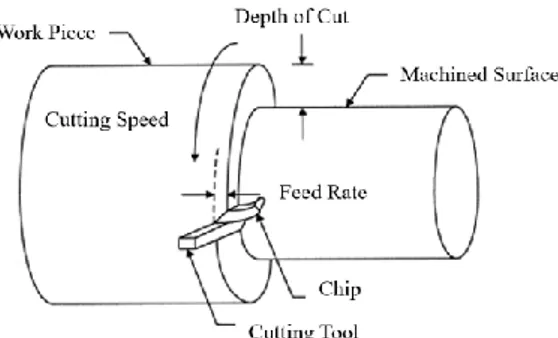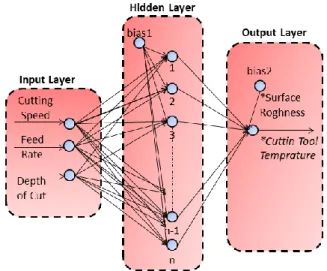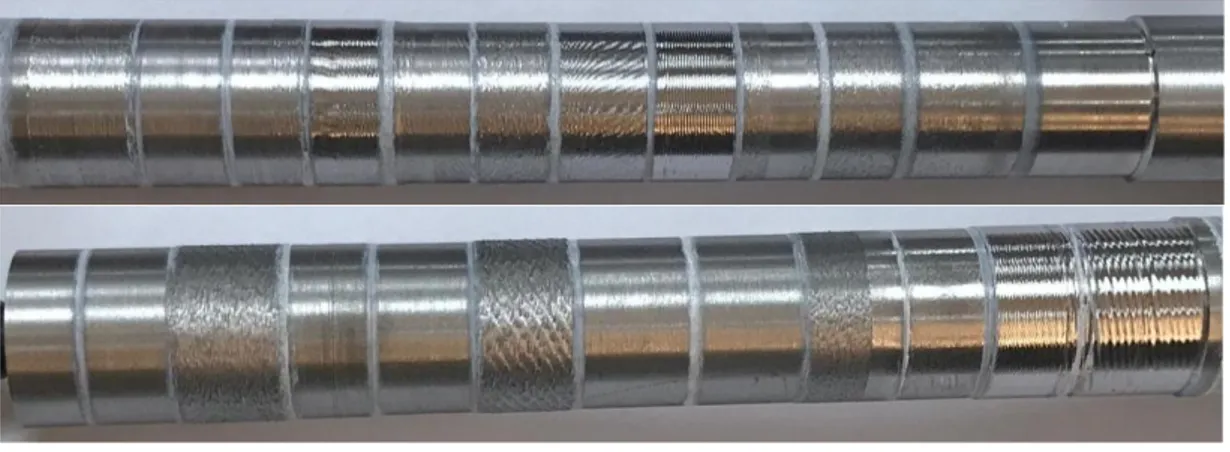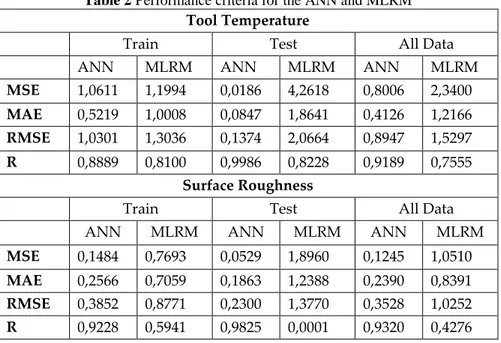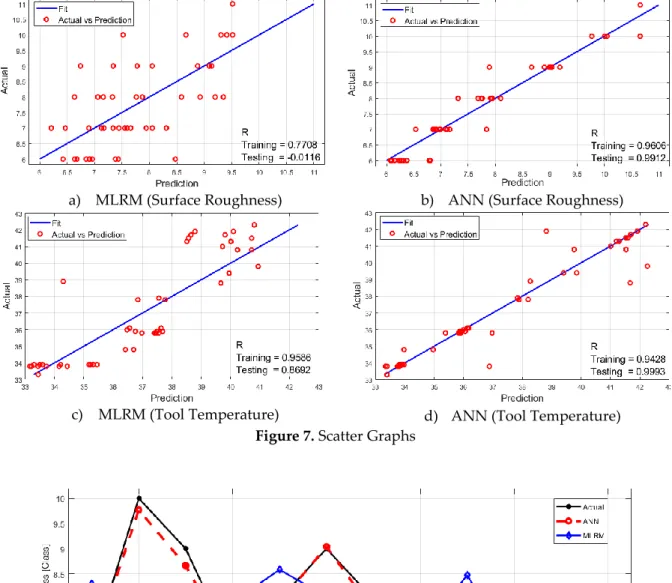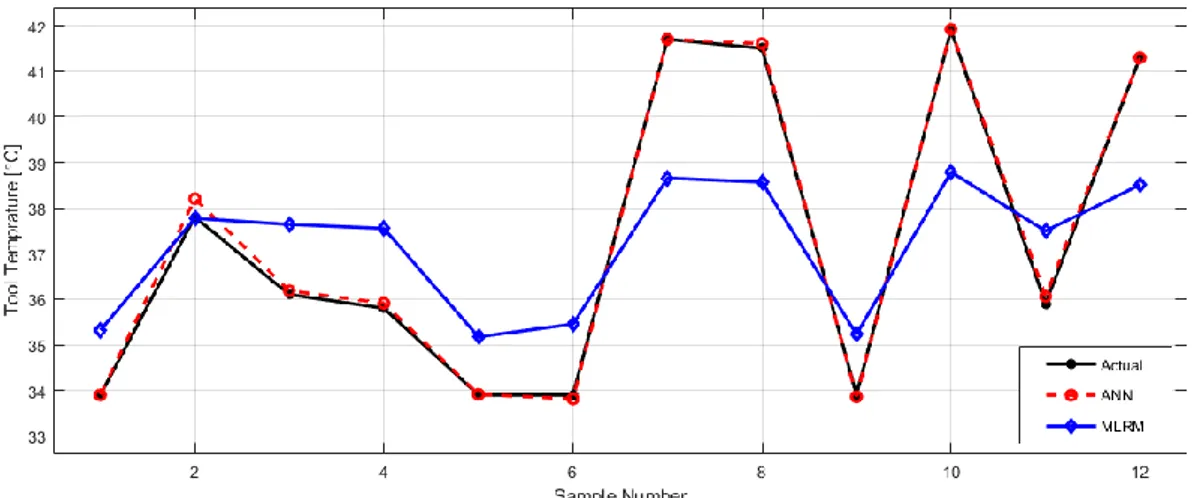A STUDY ON PREDICTION OF SURFACE ROUGHNESS AND CUTTING TOOL TEMPERATURE AFTER TURNING FOR S235JR STEEL
1Hasan Huseyin BILGIC , 2Mehmet Ali GUVENC , 3Mustafa CAKIR , 4Selcuk MISTIKOGLU
1.2.3.4Iskenderun Technical University, Faculty of Engineering and Naturel Science, Department of Mechanical Engineering, Iskenderun, Hatay, TURKEY
1hhuseyin.bilgic@iste.edu.tr, 2mali.guvenc@iste.edu.tr, 3mustafa.cakir@iste.edu.tr, 4
selcuk.mistikoglu@iste.edu.tr
(Geliş/Received: 25.09.2019; Kabul/Accepted in Revised Form: 01.11.2019)
ABSTRACT: In machining technologies, the most important criterion taken into consideration when evaluating the product quality is seen as the surface roughness. In the consideration of production quality and cost, tool wear is one of the factors that directly affect the cost of production. In the machining process, the most important parameters affecting the surface roughness and tool temperature are the cutting depth, speed and feed rate of rotation. In order to obtain the best surface quality and to keep the cost at the optimum level, the most suitable processing parameters should be selected by taking into consideration the effect of these parameters on each other. In this study, it is aimed that to prediction of surface roughness (Ra.) and tool temperature (°C) values for turning which has an important position in machining. For this purpose, Artificial Neural Networks (ANN) method and Multi Linear Regression Model (MLRM) were used separately. The data obtained from ANN, Regression Model were compared with the actual test data, and the results were examined. According to the obtained results, it is seen that the ANN method has more successful results than Regression model in surface roughness and tool temperature estimation.
Key Words: Turning, Artificial Neural Networks (ANN), Multi Linear Regression (MLR), Surface Roughness S235JR Çeliği için Tornalama İşlemi Sonrası Yüzey Pürüzlülüğü ve Kesici Takım Uç Sıcaklığının Tahmini Üzerine Bir Çalışma
ÖZ: Talaşlı üretim teknolojilerinde, ürün kalitesi değerlendirilirken dikkate alınan en önemli kıstas yüzey pürüzlüğü olarak görülmektedir. Üretim kalitesi ve maliyet dikkate alınması durumunda ise takım aşınması, üretim maliyetini doğrudan etkileyen etkenler arasında öne çıkmaktadır. Talaşlı imalat sürecinde, yüzey pürüzlüğü ve takım sıcaklığını etkileyen parametrelerin en önemlileri; kesme derinliği, devir sayısı ve ilerleme hızıdır. En iyi yüzey kalitesini elde etme ve aynı zamanda maliyeti optimum seviyede tutabilmek için bu parametrelerin birbirlerini etkileme durumları dikkate alınarak en uygun işleme parametreleri seçilmelidir. Bu çalışmada; talaşlı üretimde önemli bir konuma sahip olan tornalama için yüzey pürüzlülüğü (Ra/Aritmetik Ortalama Sapma) ve işleme sonrası takım uç sıcaklığı (°C) değerlerinin tahmin edilmesi amaçlanmıştır. Bunun için Yapay Sinir Ağları (YSA) yöntemi ve Çoklu Lineer Regresyon Modeli (ÇLRM) ayrı ayrı kullanılmıştır. Geliştirilen YSA ve Regresyon Modelinden elde edilen veriler ile gerçek test verileri karşılaştırılmış ve sonuçlar irdelenmiştir. Elde edilen sonuçlara göre yüzey pürüzlüğü ve takım sıcaklığı tahmininde; YSA yönteminin, Regresyon modeline göre daha başarılı sonuçlar verdiği görülmüştür.
increased (Akkuş, 2010; Markopoulos, Manolakos, & Vaxevanidis, 2008; Zain, Haron, & Sharif, 2010). The development that started with the use of AI concept in the 1950s for the first time is increasing day by day. Increasing development with increasing acceleration has enabled the use of AI in industrial applications (Bilgic et al, 2016; Mert & Arat, 2014). Today, the most widely used AI methods are Artificial Neural Networks (ANN) (Wenden, 1981b), Fuzzy Logic (Zadeh & Jose, 1975), Machine Learning and Bee Colony Algorithm (Karaboga & Basturk, 2007; Bilgic et al., 2016), Genetic Algorithms (Goldberg & Holland, 1988), Ant Colony Optimization Algorithms (Dorigo & Di Caro, 1999; Çakır et al., 2011), Taguchi method (Guvenc et al., 2019) and etc. ANN is one of the most commonly used method for estimating parameters in non-linear systems.
In machining process, the most important parameters affecting surface roughness and tool temperature are cutting depth, speed and feed rate. In order to obtain the best surface quality and at the same time to keep the cost at an optimum level, the most suitable machining parameters should be selected considering the influence of these parameters on each other.
Lu emphasized that there were large number of uncontrollable factors that surface quality and used radial basis function neural network to predict surface quality of machined workpiece (Lu, 2008). Abouelatta and Madl collected and analyzed surface roughness and cutting vibration parameters with commercial software packages to predict surface roughness parameters with 4 different model as functions of cutting parameters and tool vibrations (Abouelatta & Mad, 2001). Öztürk and co-workers used Bees algorithm as heuristic optimization method to optimize the parameters of cutting. Some researchers proposed response surface methodology to predict surface roughness and delimitation in end milling of composite materials with ANN (Raj et. al, 2012) and support vector regression (Mia & Dhar, 2019; Jurkovic et. al., 2018) in high speed turning process. Singh and Rao investigated the influence of tool geometry on the surface roughness and the effect of cutting conditions in their study (Singh & Rao, 2007).
In this study, S235JR quality, 35 mm diameter cylindrical material is processed by turning. Surface roughness and tool temperature data were recorded after turning. Obtained data were used for ANN and MLRM training. After the completion of the training; Surface roughness and tool temperature were estimated using 12 different sample sets. The estimation data obtained were evaluated according to various performance criteria.
MATERIALS and METHODS
Machining is the most common metal forming method used in the mechanical manufacturing industry (Dahbi, Ezzine, & El Moussami, 2017). The main machining methods are milling, turning, drilling and grinding (Harun, 2010). Turning, which is one of the manufacturing processes of the cutting tool between metal cutting methods, is commonly used to remove unwanted materials from the surface of a rotating cylindrical workpiece to achieve the desired shape. In the turning process, the cutting tool is fed linearly parallel to the axis of rotation. In turning, in addition to the tool and workpiece material, the cutting speed (v, rpm), feed rate (f, mm/rev) and depth of cut (d, mm) are the parameters that affect the surface quality the most. The turning process and these three parameters are shown schematically in Figure 1. In the turning process C: 0:22; P: 0.05; S: 0.045; N: 0.072; S235JR steel material with a Mn<1.4 composition was used.
Figure 1. Turning schematic illustration Artificial Neural Networks
ANN which inspired by the human nervous system is composed of artificial neurons that are interconnected. Artificial neurons, which work in a similar way as biological neurons, evaluate the information received to it and send it to the other neuron or output unit. Figure 2 presents the structure of the artificial neuron.
Figure 2. The Structure of Artificial Neuron
Here, the artificial neuron collects the information that comes before it by multiplying it with weights according to its importance. The bias (threshold value) is added to make subsequent data meaningful in the transfer function, and the output value is transmitted to the next neuron or generates the output. Tangent-Sigmoid transfer function and its mathematical function presented in Figure 3 and Equation 1 was used in the study.
Figure 3. Transfer Function of Tangent Sigmoid
F(x)=1/1+e-x (1)
In this study, feed-forward backpropagation network architecture is used as the network structure presented in Figure 4.
Figure 4. Structure of ANN Model Multiple Linear Regression Model (MLRM)
MLRM is different from Simple Linear Regression (SLR). Dependent variable or variables are calculated by considering multiple independent variables for the MLRM (Preacher & Rucker, 2003).
0 1 1 2 2 ... j e
Y X X X
(2)
In equation 2, Y denotes the variable dependent on X, where 0 denotes the line where the line
intersects the y-axis, 1 represents the regression coefficient (slope of the line), βj represents the jth
parameter, and represents the chance-dependent error value. The values 0 and 1-j are theoretical
values calculated using the entire dataset. The success of the dependent variable Y calculated with the help of X-linked regression model can be evaluated with various performance measures.
2 1 ( )
1
N i obs iMSE
Y
Y
N
(3) 1
1
N i obs iMAE
Y
Y
N
(4) 1 2 1 N i obs i RMSE Y Y N
(5) 2 2 1 1 (1 ) adj N N k R R
(6)In this study, MSE (Mean Square Error), RMSE (Root Mean Square Errors), MAE (Mean Absolute Error) and R2 (coefficient of determination) were used to determine the success of the models presented
by equations 3, 4, 5 and 6.
RESULTS and DISCUSSION
In this study, the universal lathe was used with HSS (High Speed Steel) cutting tool for different cutting speed, feed rate and depth of cut values. Surface roughness class and cutting tool temperature data were obtained from 48 different test results. Processing results of the samples used are shown in Figure 5.
Figure 5. Machining Samples
The properties of the gauge tool used to determine the surface roughness class are classified according to the values given in Table 1. The tool temperature and surface roughness images after turning are presented in Figure 6.
Table 1. Surface roughness classes
Figure 6. Chip removal and temperature measurement
Tool removal temperature was obtained by HT-175 model with 10% accuracy. 36 of the 48 data obtained were obtained by using 370, 540, 800 and 1200 rpm cutting speed, 0.3, 0.5 and 1 mm / rev feed rate and 0.5, 1 and 1.5 mm depth of cut and combinations. The 36 data collected were used as training and test data for ANN and MLRM. Then, surface roughness class and cutting tool temperature values were estimated for values that ANN and MLRM had not seen before. Weights and related equations calculated for parameters of surface roughness class (P) and cutting tool temperature (T) are shown in Equations 7 and 8. P=5,7165-v.0,0061+f.3,5075+d.0,4257 (7) T=29,362+v.0,0032+f.1,4189+d.6,503 (8) Class Ra (
m) Rz (
m) N6 0,8-32 3,2-128 N7 1,6-63 6,1-244 N8 3,2-125 12,2-488 N9 6,3-250 23,7-950 N10 12,5-500 47,5-1900 N11 25-1000 95-3800intermediate neurons were selected for estimation of tool tip temperature.
As a result of the training, 12 data sets were used in both models and the estimation process was made by entering the data of the network. Table 2 presents the performance criteria for education, testing and all data obtained through the MLRM and ANN model. The scatter graphs of the training and test process are shown in Figure 7. In order to see the success of the models clearly, surface roughness class and tool temperature are presented as graphs in Figure 8 and 9.
Table 2 Performance criteria for the ANN and MLRM Tool Temperature
Train Test All Data
ANN MLRM ANN MLRM ANN MLRM
MSE 1,0611 1,1994 0,0186 4,2618 0,8006 2,3400
MAE 0,5219 1,0008 0,0847 1,8641 0,4126 1,2166
RMSE 1,0301 1,3036 0,1374 2,0664 0,8947 1,5297
R 0,8889 0,8100 0,9986 0,8228 0,9189 0,7555
Surface Roughness
Train Test All Data
ANN MLRM ANN MLRM ANN MLRM
MSE 0,1484 0,7693 0,0529 1,8960 0,1245 1,0510
MAE 0,2566 0,7059 0,1863 1,2388 0,2390 0,8391
RMSE 0,3852 0,8771 0,2300 1,3770 0,3528 1,0252
a) MLRM (Surface Roughness) b) ANN (Surface Roughness)
c) MLRM (Tool Temperature) d) ANN (Tool Temperature)
Figure 7. Scatter Graphs
Figure 9. Model Results of Tool Temperature CONCLUSION
In this experimental study, surface roughness and tooltip temperature values which are among the most important outputs in determining product quality in machining are estimated. MLRM, which is one of the traditional methods, has been used in the prediction studies together with the ANN method which is one of the most frequently used AI estimation methods. ANN and MLRM have been created separately and estimation have been done with the obtained models. According to the results obtained in surface roughness and tool temperature estimation, the ANN method was found to be more successful than MLRM.
REFERENCES
Abouelatta, O. B., & Madl, J. (2001). Surface roughness prediction based on cutting parameters and tool vibrations in turning operations. Journal of materials processing technology, 118(1-3), 269-277. Akkuş, H. (2010). Tornalama işlemlerinde yüzey pürüzlülüğünün istatistiksel ve yapay zeka
yöntemleriyle tahmin edilmesi (Doctoral dissertation, Selçuk Üniversitesi Fen Bilimleri Enstitüsü).
Bilgic, H. H., Sen, M. A., & Kalyoncu, M. (2016). Tuning of LQR controller for an experimental inverted pendulum system based on The Bees Algorithm. Journal of Vibroengineering, 18(6), 3684-3694. Bilgic, H. H., Yağlı, H., Koç, A., & Yapıcı, A. (2016). Deneysel bir organik rankine çevriminde yapay sinir
ağları (Ysa) yardımıyla güç tahmini. Selçuk Üniversitesi Mühendislik, Bilim Ve Teknoloji Dergisi, 4(1), 7-17.
Childs, T. (2000). Metal Machining Theory and Applications. Materials Technology, 416.
Çakır, M., Oral, M., & Aydın, A. (2011) Karanca Koloni Optimizasyon Algoritmaları ile Risk Faktörlerine Bağlı Optimum Hastane Yerleşim Noktasının Bulunması. Engineering Sciences, 6(1), 195-208. Dahbi, S., Ezzine, L., & El Moussami, H. (2017). Modeling of cutting performances in turning process
using artificial neural networks. International Journal of Engineering Business Management, 9, 1847979017718988.
Dorigo, M., & Di Caro, G. (1999). Ant colony optimization: A new metaheuristic, evolutionary computation. CEC 99. Proceedings of the 1999 Congress On, 2.
Goldberg, D. E., & Holland, J. H. (1988). Genetic algorithms and machine learning. Machine learning, 3(2), 95-99.
Guvenc, M. A., Cakir, M., Mistikoglu, S. (2019). Experimental Study on Optimization of Cutting Parameters by Using Taguchi Method for Tool Vibration and Surface Roughness in Dry Turning of AA6013. 10th International Symposium on Intelligent Manufacturing and Service Systems. 1032-1040
Jurkovic, Z., Cukor, G., Brezocnik, M., & Brajkovic, T. (2018). A comparison of machine learning methods for cutting parameters prediction in high speed turning process. Journal of Intelligent Manufacturing, 29(8), 1683-1693.
Karaboga, D., & Basturk, B. (2007). A powerful and efficient algorithm for numerical function optimization: Artificial bee colony (ABC) algorithm. Journal of Global Optimization, 39(3), 459–471.
Lu, C. (2008). Study on prediction of surface quality in machining process. Journal of materials processing technology, 205(1-3), 439-450.
Markopoulos, A. P., Manolakos, D. E., & Vaxevanidis, N. M. (2008). Artificial neural network models for the prediction of surface roughness in electrical discharge machining. Journal of Intelligent Manufacturing, 19(3), 283–292.
Mert, I., & Arat, H. T. (2014). Prediction of heat transfer coefficients by ANN for aluminum & steel material. International Journal, 5(2), 2305-1493.
Mia, M., & Dhar, N. R. (2019). Prediction and optimization by using SVR, RSM and GA in hard turning of tempered AISI 1060 steel under effective cooling condition. Neural Computing and Applications, 31(7), 2349-2370.
Öztürk, O., Kalyoncu, M., & Ünüvar, A. (2018). Multi objective optimization of cutting parameters in a single pass turning operation using the bees algorithm. 1st International Conference on Advances in Mechanical and Mechatronics Engineering.
Preacher, K. J., & Rucker, D. (2003). A primer on interaction effects in multiple linear regression. Retrieved November, 10, 2003.
Raj, P. P., Perumal, A. E., & Ramu, P. (2012). Prediction of surface roughness and delamination in end milling of GFRP using mathematical model and ANN.
Singh, D., & Rao, P. V. (2007). A surface roughness prediction model for hard turning process. The International Journal of Advanced Manufacturing Technology, 32(11-12), 1115-1124.
Wenden, A. L. (1981a). Machining Fundamentals and Recent Advances. (J. P. Davim, Ed.) (Vol. 3). Springer.
Wenden, A. L. (1981b). Two Neural Network Programming Assignments Using Arrays. In SIGCSE ’91 Proceedings of the twenty-second SIGCSE technical symposium on Computer science education (Vol. 3, pp. 43–47).
Zadeh, L. A., & Jose, S. (1975). The Concept of a Linguistic Variable II. Electrical Engineering, 357, 301– 357.
Zain, A. M., Haron, H., & Sharif, S. (2010). Prediction of surface roughness in the end milling machining using Artificial Neural Network. Expert Systems with Applications, 37(2), 1755–1768.
